The “Kondaveeti Raaja” concept captures the imagination of the Aandhras to this day. Truly, this era was the Romantic Age of Andhra, not just for its poets or cultured kings, but also for its brave cavaliers and formidable fortresses.
Following the First Article in our Series on Fortresses of the Telugus, we proceed with the natural next post: Kondaveedu Fort.
History
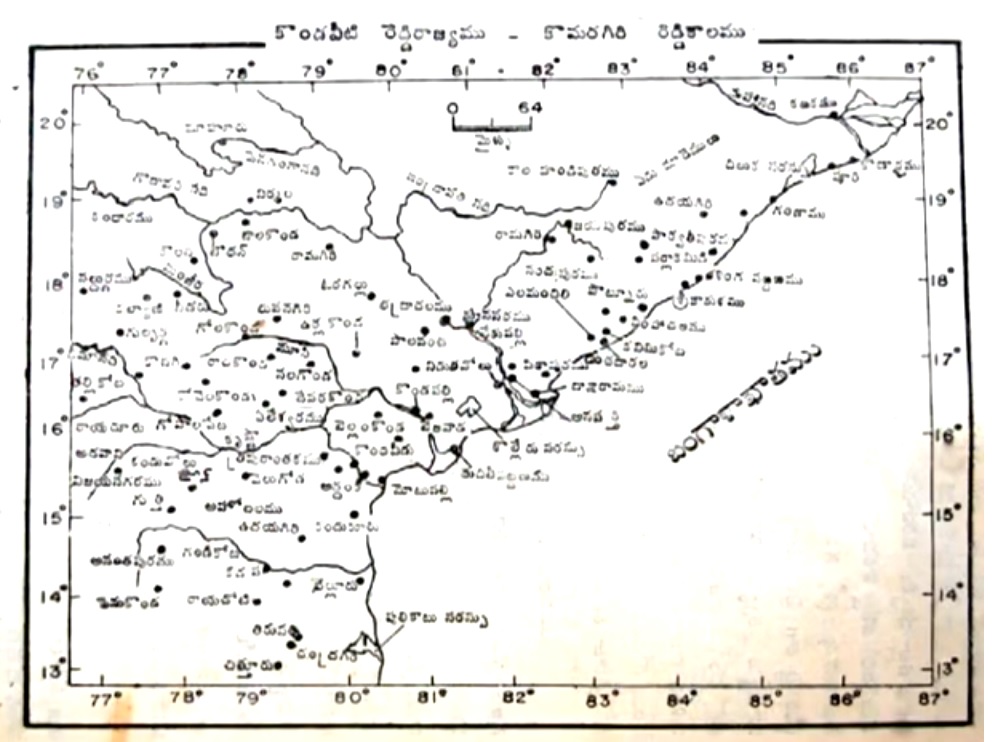
“Kondaveedu is the largest hill fort in present Andhra Pradesh state, situated about 27 kms southwest of Guntur city. This fort is in the Kondaveedu hills range. Prolayavemareddy started construction of an impregnable fort at Kondaveedu in about 1335 AD” [3]
The Annals of Aandhra History are hallowed with heroes and heroines who fought to preserve not only their language and culture, but also their dharma. Unlike the current crop of caste obsessed cravens in the Telugu populace today, the Kings and commanders of medieval Aandhra had a clear sense of who they were and just how to deal with foreign invaders. “Settlers” are not those who are fellow ethnic but economic migrants. Rather, the true settler-colonists are those who invade from a foreign culture and ill-treat or enslave the local population. Those who attempt to impose their language, culture and religion can never be the true natives of the land. Only fools, malcontents, and sellouts make common cause with common foes.
Unlike the traitors of Devarakonda (somehow celebrities today…), the Reddi Raajas knew the difference between right vs wrong, and rival vs coloniser. These great commanders then rose to kingship by defeating these foreign barbarians and reconstructing or building great fortresses like Kondaveedu.
The next ruler after Prolayya Vema was Anavota Reddi (1353-1364). After succeeding his father as King, he shifted the capital from Addanki to Kondaveedu (to protect the kingdom from Vijayanagara invasions), the city which became legendary for its “Kondaveeti Raja”. Attacked on all sides (Gangas from the North, Recherlas & Bahmani Alliance from the West, and Vijayanagara from the South, Anavota’s main achievement was keeping the Reddi kingdom together.
Due to the invasion of Bukka Raya I, Anavota was forced to change the capital from Addanki to Kondaveedu, “a more impregnable place than the former, in the Narasaaraopet taluk of Guntoor district.” [1, 104]. Kondaveedu or Kundinapura, has a long history. Most date it back to the Chola dynasty, but recent history indicates it was an active Buddhist site in Satavahana times.

Long time ACP readers would remember King Anavema as the son of Prolaya Vema and brother of Anavota. They are notable for being part of the Musunuri Nayaks revolutionary war against the tyranny of Delhi Turks, and they later became independent kings after the Rachakonda Recherlas betrayed Kapaneedu.
“In [t]he history of Andhradesa Reddis of Kondaveedu occupy a prominent place by their political sway, patronage of literature, uplift of ‘Dharma’ endowments to temples and generous grants of land and villages to learned brahmins, especially belonging to Velanadu. To this dynasty belonged Anavema also known as ‘Dharma’ vemana’.” [1, 15]
The Wazirabad (Vadapalli) inscription dated to Saka 1299 records a battle between the Recherlas and the Reddis. “This record proves that Anavema scored a decisive victory over the Recerla chiefs, and annexed to the Kondaveedu kingdom, at least a portion of the dominion lying to the north of the Krsna.” [1, 119]. The Boorugugadda inscription in Nalgonda provides further evidence.
Following Anavema, the great Vasantaraya, better known as Kumaaragiri, then took the throne of Kondaveedu. He presided over the most widespread, successful campaigning of the Reddi Kingdom, with commanders such as Kataya Vema and Allaya Reddi. Under him, Coastal Aandhra arms reached as far as Odisha, Bengal and Jharkhand. He also led a building programme which beautified Kondaveedu and constructed many structures such as the grha-raja samjhanam, dedicated to Goddess Lakshmi
“With the death of Kumaaragiri, Kaataya Vema, who was already opposed to Peda Komati Vema, never recognised the latter as his sovereign. He defied his authority and asserted his independence. The act of Kumaaragiri in conferring the Rajamahendravara Raajya on Kaataya Vema thus turned out to be the greatest political blunder of his rule. It divided the Reddi kingdom into two halves, each fighting against the other, and made it an easy prey to its neighbours who had long been casting hungry looks on it” [1, 159]
Kondaveedu was at the centre of this battle of rivals. It is from here that the beginning of the Reddi Raajyam’s end was determined. At a time when the Telugu kings should have been actively working to take back Warangal and Golkonda, they were caught in internecine warfare due to petty revenge and ambition.
“Desiring to arrest the internal disorder and the attacks all around on the Reddi kingdom, Peda Komati Vema appears to have seized the throne of Kondavidu by force. Some of the nobles, like Velugoti Raayapa Naayaka and Gajaraavu Tippaa Naayaka, fought on the side of Peda Komati Vema in this war of succession, and helped him considerably in gaining the throne”. [1, 157] Gajaravu defeated Kaataya Vema. The latter is likely to have coordinated with Harihara II of Vijayanagara in order to invade Kondaveedu, but this was defeated by Gajaraavu Tippaa Naayaka.
“Peda Komati Vema vigorously prosecuted his campaign against Raajamahendravara Rajya which finally ended with the death of his bitter opponent Kaataya Vema. Kaataya Vemuni-talagonda-ganda (one who took the head of Kaataya Vema, probably in battle” [1, 161] Not much was recorded about the ‘War of Succession’. There was an alliance between Vijayanagara and Rajamahendri on one side and Kondaveedu and Annadeva Choda of Polavaram on the other. Kaataya Vema’s son Kumaaragiri II did not rule for long. He was opposed by Allaya Reddi, who took up the cause of Anitalli.
“Allaya Vema may be said to have defeated the Sultaan of Bengal also during this campign as is borne out by the term Pandua…This eastern campaign of the Reddi kings of Kondaveedu was a very extensive one. The Reddi armies marched as far as Cuttack in the east, as far as the capital of the Sultaans of Bengal in the north and as far as the confines of the Central Provinces in the west.”[1, 143]
This meteoric military career did not remain for long. Despite the heroics of Allaya Vema, the vultures began circling around the rump Reddi Raajyam. Decline was now inevitable. A new war was prosecuted between Kondaveedu and Vijayanagara.
This war was a disaster for Peda Komati and “the beginning of the end of Kondaveedu kingdom…Peda Komati Vema appears to have spent his last years of rule in fighting against the Recerla kings of Raajukonda and Devarakonda.” [1, 186]. PKV is thought to have died in battle with the Velamas. “Peda Komati’s rule may be said to have ended in Saka 1342 (1420 A.D.). Komati Vema was a great warrior, a profound scholar and a considerable poet…He also committed the same folly as his predecessor, Kumaaragiri in further dividing the kingdom between himself and his brother, Maacaa Reddi.” [1, 187] Maachaa Reddi would rule from Kandukuru (near Nellore), making it the 3rd of the Three Reddi Kingdoms.
The epilogue of Kondaveedu’s history can be summed up as serving as a guest house for outsiders. The first of these was the Gajapathis of Odisha.
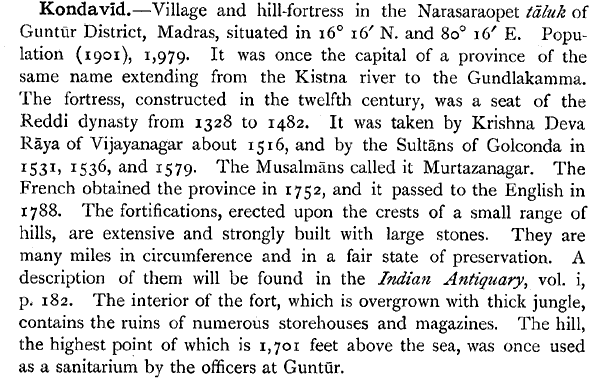
Architecture
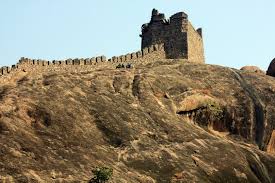
“It is famous for lakes, forest with 56 kinds of herbal plants, hills and a beautiful description of the fort was made by the great poets like Srinatha and later in 20th century by Duvuri Ramireddy in their writings. once we enter the fort, either from the east or west we indispensably encounter with enchanting water tanks namely Muttyalamma cheruvu(Kunalamma), Puttalamma cheruvu, Vedulla cheruvu. If we walk through this valley feast our eyes in the beauty all-round us.” [3]
However, long before it had become a fortress or even a temple village, there are indications that Kondaveedu was a Buddhist site in the Satavahana era.
“the sthupa structure measuring 12.5 ft in diametre, 4.5 ft in height consisting of layers of well-dressed Palnadu lime stone which the Buddhists preferred. The bottom-most layer was carved with lotus flower design representing the mature phase of typical Amaravathi School of Art” [7]
The newly found stupa aside, Kondaveedu is notable for 3 key aspects: 1) bastions 2) water tanks 3) temples.
Bastions (Burujus)
Prior to Kondareddi Buruju etching itself in the minds of the men and women of Raayalavaariseema, the numerous bastions of the Kondaveeti Raajas played their role in history.
“Kondaveedu fort commands a picturesque view from Nemmalla buruju(bastion), south of Nemmala buruju hills sprawling over three kilometers up to NH5 with green forest. apart from Nemmalla buruju there are 22 buruju’s, some of which are Tara buruju or Chukkala konda buruju, Jetty buruju, A.ramanal buruju” [3]
Kondaveedu itself stands 500metres above sea level. From this promontory, the burujus then proliferate and predominate. Nemalla buruju is said to be the largest.
“Of all the Bastions Taraburuju is most impressive eye catching and an icon of Kondaveedu fort. As we know, that Kondaveedu fort was built in hills which are more or less in an oval shape.” [3]
Water Tanks
“Kavi Sarvabhowma Srinathudu worked as an education officer at King Pedakomati Vemareddy’s court. Ancient inscriptions issued by Queen Suramamba, wife of King Prolaya Vemareddy were also seen at Phirangipuram. The inscription was issued on the occasion of inauguration of a tank for drinking water and irrigation purposes in 1415 AD.” [5]

Along with these bastions, and interconnecting walls, a proper fortress requires a proper water supply. Dotted with numerous water tanks, and ponds (cheruvus), Kondaveedu is well-supplied to withstand protracted sieges. In fact, during the illustrious reign of the valiant Emperor Krishnadeva Raya, a terrible siege took place between Vijayanagara and the Odisha Gajapathis. The General Saluva Thimma is credited with finding a secret passage way through which the fortress could be taken.
In any event, 3 water tanks are the most significant. These are Muthyaalamma, Puttalamma, and Vedulla (Bamboo) cheruvus. Despite this hydrological beneficence to posterity, the temples in Kondaveedu and its Chilakaluripeta vicinity are what underscore its sanctity.
Temples

Today, Kondaveedu is known for a number of temples situated at the site. Standing upon 3 hills, there are 3 prominent temples that mark the landscape, along with a number of minor places of worship.
“Due to its height from the sea level, Kondaveedu Fort was considered as one of the strongest forts. The Ramalingeswara and Narasimha Swamy temples in Kondaveedu, Mulankareswari temple at Aminabad, Siva temple on the hillock and Narasimha Swamy temple are in a state of ruin. Reddy kings used to perform special prayers to Goddess Mulakareswari before going to wars. ” [5]
“Kattulabavi or Gopinath temple in Kota village on the foothills of Kondaveedu fort, the biggest single building and one of the most captivating monuments, said to have been built by Vijayanagara king Atchutaraya, in this region a good example or specimen of Vijayanagara style both for art and architecture.
Local people call it Kattulabavi, regarding this name a story has been in a wide circulation, as for folk lore and local regards, in order to suppress the rebellion of 72 poligars of that region, minister Ramayabhaskara conceived a plan, according to which, a well was dug in the temple garbha gruha in which swords were arranged…72 poligars were invited to the temple to the ongoing celebrations and made them pass into the well one by one and cut into pieces.” [3]
“Remains of Sri Lakshminasimha Swamy temple, Sri Venkateswara Swamy temple, Dargah, an old well and many monuments dated back to centuries ago were unearthed at the Kondaveedu Fort in Yadlapdu mandal of Guntur district. ” [4]
Legacy

The legacy of Kondaveedu continues to inspire true Telugus to this day. Unlike those nizam ghulams who offend the memory of the brave Telugus of the Sayudha Poratam, like Chakili Ailamma, real Aandhras know how their ancestors resisted foreign invaders who did actual imposition of not only language and culture, but even religion. Fortunately, in that era, great heroes like Prataparudra Kakatiya, Krishna Nayaka, and Prolaya Reddi fought and frequently defeated cruel barbarians from central asia.
Real objective history doesn’t whitewash the atrocities committed against a society. It doesn’t lie and digest the three native cultures of Telugu, Kannada, and Marathi into some artificial “deccan” identity. Rather, real history documents what actually happened, celebrates the heroes who resisted, but also doesn’t hold present generations responsible. Instead, it asks them to learn the lessons of history and to encourage all citizens today—regardless of caste or creed—to preserve and propagate the native language and culture.
The Great Fortress of Kondaveedu stands as testament to that legacy. It was the awesome eyrie from which the Reddi Raajas resisted foreigner invaders. It is why they will be forever known as the Kondaveeti Raajas.
References:
- M.Somasekhara Sarma. History of the Reddi Kingdoms.Delhi:Facsimile Publ. 2015
- Rao, P.R. History and Culture of Andhra Pradesh: From the earliest times to 1991. Delhi: Sterling. 1994
- Kondaveedu Fort. https://kondaveedufort.com/
- “Guntur: Glory of Kondaveedu Revealed”. The Hans India. https://www.thehansindia.com/andhra-pradesh/guntur-glory-of-kondaveedu-fort-revealed-602023
- “Kondaveedu Fort awaits Makeover”. The Hans India. https://www.thehansindia.com/posts/index/Andhra-Pradesh/2016-04-26/Kondaveedu-Fort-awaits-makeover/224257
- Imperial Gazetteer of India:Volume 17: Provincial Series. Supt. of Govt. Print. 1908. p. 336
- “”Andhra Pradesh: Kondaveedu a Buddhist settlement 2000 years”. Times of India. https://timesofindia.indiatimes.com/city/vijayawada/kondaveedu-a-buddhist-settlement-2000-years-ago/articleshow/67616353.cms
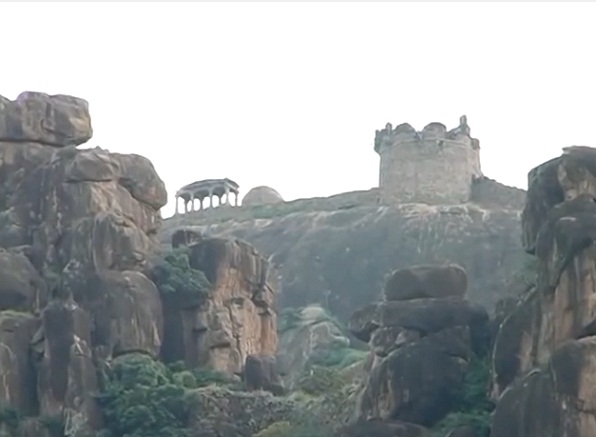

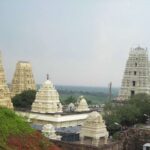
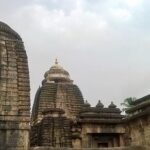
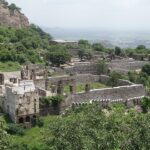



In Kondaveedu fortress, there is hidden, soundless sacred music.
Kondaveeti raajulu! What a deep post, Nripathi. I liked it more for the temples though 😉
Thanks, VT. As you know, I’m more of a fort person myself. Kondaveedu Kota! 🙂
I’m so happy to find this site about Ancient Andhrans long before the Islamic destruction and British invasions. I want to learn more about my ‘people’.